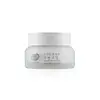What's inside
What's inside
 Key Ingredients
Key Ingredients

 Benefits
Benefits

 Concerns
Concerns

 Ingredients Side-by-side
Ingredients Side-by-side

Water
Skin ConditioningDimethicone
EmollientGlycerin
HumectantPropylene Glycol
HumectantPropanediol
SolventPanthenol
Skin ConditioningDimethicone/PEG-10/15 Crosspolymer
Bisabolol
MaskingDiisopropyl Sebacate
EmollientSodium Chloride
MaskingPhenoxyethanol
PreservativePolymethylsilsesquioxane
Chlorphenesin
AntimicrobialCitrus Limon Peel Oil
MaskingSodium Citrate
BufferingCalendula Officinalis Flower Extract
MaskingLimonene
PerfumingPEG-10 Dimethicone
Skin ConditioningTrisodium Ethylenediamine Disuccinate
Calendula Officinalis Flower
Skin ConditioningCitric Acid
BufferingDipropylene Glycol
HumectantGeranium Maculatum Oil
MaskingChamomilla Recutita Flower Oil
MaskingCitral
PerfumingCitronellol
PerfumingGeraniol
PerfumingFarnesol
PerfumingLinalool
PerfumingTocopherol
AntioxidantCymbopogon Schoenanthus Oil
MaskingArtemisia Absinthium Extract
Skin ConditioningWater, Dimethicone, Glycerin, Propylene Glycol, Propanediol, Panthenol, Dimethicone/PEG-10/15 Crosspolymer, Bisabolol, Diisopropyl Sebacate, Sodium Chloride, Phenoxyethanol, Polymethylsilsesquioxane, Chlorphenesin, Citrus Limon Peel Oil, Sodium Citrate, Calendula Officinalis Flower Extract, Limonene, PEG-10 Dimethicone, Trisodium Ethylenediamine Disuccinate, Calendula Officinalis Flower, Citric Acid, Dipropylene Glycol, Geranium Maculatum Oil, Chamomilla Recutita Flower Oil, Citral, Citronellol, Geraniol, Farnesol, Linalool, Tocopherol, Cymbopogon Schoenanthus Oil, Artemisia Absinthium Extract
Oryza Sativa Extract 78.91%
AbsorbentAloe Barbadensis Leaf Extract 10%
EmollientDaucus Carota Sativa Seed Oil 1%
EmollientOlea Europaea Fruit Oil 1%
MaskingCetearyl Olivate
Sorbitan Olivate
EmulsifyingCopernicia Cerifera Wax 1%
Natto Gum
Prunus Armeniaca Kernel Oil 0.5%
MaskingVitis Vinifera Seed Oil 0.5%
EmollientCamellia Japonica Seed Oil 0.05%
EmollientPersea Gratissima Oil 0.5%
Skin ConditioningButyrospermum Parkii Butter 0.5%
Skin ConditioningRice Ferment Filtrate 0.1%
Skin ConditioningLactobacillus/Aloe Barbadensis Ferment Filtrate 0.1%
Skin ConditioningLactobacillus 0.2%
Skin ConditioningScutellaria Baicalensis Root Extract
AstringentPaeonia Suffruticosa Root Extract
Skin ProtectingGlycyrrhiza Glabra Root Extract
BleachingCyamopsis Tetragonoloba Gum
Emulsion StabilisingAlkanna Tinctoria Root Extract
Skin ConditioningAlcohol 0.5%
AntimicrobialLavandula Angustifolia Oil
MaskingCitrus Aurantifolia Oil
CleansingCitrus Limon Fruit Oil
AstringentAniba Rosaeodora Wood Oil
AstringentSilica
AbrasiveGeranium Maculatum Oil
MaskingCitrus Aurantium Bergamia Fruit Oil
MaskingGeraniol
PerfumingLinalool
PerfumingCitronellol
PerfumingLimonene
PerfumingOryza Sativa Extract 78.91%, Aloe Barbadensis Leaf Extract 10%, Daucus Carota Sativa Seed Oil 1%, Olea Europaea Fruit Oil 1%, Cetearyl Olivate, Sorbitan Olivate, Copernicia Cerifera Wax 1%, Natto Gum, Prunus Armeniaca Kernel Oil 0.5%, Vitis Vinifera Seed Oil 0.5%, Camellia Japonica Seed Oil 0.05%, Persea Gratissima Oil 0.5%, Butyrospermum Parkii Butter 0.5%, Rice Ferment Filtrate 0.1%, Lactobacillus/Aloe Barbadensis Ferment Filtrate 0.1%, Lactobacillus 0.2%, Scutellaria Baicalensis Root Extract, Paeonia Suffruticosa Root Extract, Glycyrrhiza Glabra Root Extract, Cyamopsis Tetragonoloba Gum, Alkanna Tinctoria Root Extract, Alcohol 0.5%, Lavandula Angustifolia Oil, Citrus Aurantifolia Oil, Citrus Limon Fruit Oil, Aniba Rosaeodora Wood Oil, Silica, Geranium Maculatum Oil, Citrus Aurantium Bergamia Fruit Oil, Geraniol, Linalool, Citronellol, Limonene
 Reviews
Reviews

Alternatives
Ingredients Explained
These ingredients are found in both products.
Ingredients higher up in an ingredient list are typically present in a larger amount.
Citronellol is used to add fragrance/parfum to a product. It is often derived from plants such as roses. In fact, it can be found in many essential oils including geranium, lavender, neroli, and more. The scent of Citronellol is often described as "fresh, grassy, and citrus-like".
Since the Citronellol molecule is already unstable, Citronellol becomes irritating on the skin when exposed to air.
Citronellol is a modified terpene. Terpenes are unsaturated hydrocarbons found in plants. They make up the primary part of essential oils.
Citronellol is not able to be absorbed into deeper layers of the skin. It has low permeability,
Citronellol is also a natural insect repellent.
Learn more about CitronellolGeraniol is used to add fragrance/parfum to a product. It is the main component of citronellol. It is a monoterpenoid and an alcohol.
Monoterpenes are naturally found in many parts of different plants.
Geraniol can be found in many essential oils including Rose Oil and Citronella Oil. The scent of Geraniol is often described as "rose-like". Many foods also contain Geraniol for fruit flavoring.
Geraniol can irritate the skin when exposed to air. However, irritation depends on the ability of geraniol to penetrate into the skin. In general, geraniol is not able to penetrate skin easily.
Geraniol is colorless and has low water-solubility. However, it is soluble in common organic solvents.
Like citronellol, it is a natural insect repellent.
2,6-Octadien-1-ol, 3,7-dimethyl-, (2E)-
Learn more about GeraniolGeranium Maculatum Oil is an oil.
Limonene is a fragrance that adds scent and taste to a formulation.
It's found in the peel oil of citrus fruits and other plants such as lavender and eucalyptus. The scent of limonene is generally described as "sweet citrus".
Limonene acts as an antioxidant, meaning it helps neutralize free radicals.
When exposed to air, oxidized limonene may sensitize the skin. Because of this, limonene is often avoided by people with sensitive skin.
The term 'fragrance' is not regulated in many countries. In many cases, it is up to the brand to define this term. For instance, many brands choose to label themselves as "fragrance-free" because they are not using synthetic fragrances. However, their products may still contain ingredients such as essential oils that are considered a fragrance.
Learn more about LimoneneLinalool is a fragrance and helps add scent to products. It's derived from common plants such as cinnamon, mint, citrus, and lavender.
Like Limonene, this ingredient oxidizes when exposed to air. Oxidized linalool can cause allergies and skin sensitivity.
This ingredient has a scent that is floral, spicy tropical, and citrus-like.
Learn more about Linalool